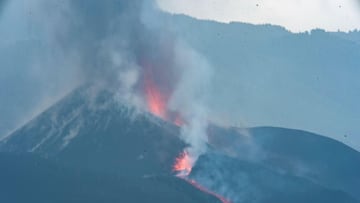Where are most volcanoes located?
Volcanism is responsible for over 80 percent of Earth’s surface both above and below sea level, but where are the most volcanos located today?

Volcanoes are found the world over, forming mainly at the edges of tectonic plates but can also arise over “hot spots” such as the one that created the Hawaii Islands. In total there are potentially some 1,500 active volcanoes on Earth according the US Geological Survey. Of those, 51 are now in continuing eruption status, the most recent On La Palma in the Canary Islands.
Many of those volcanoes are located on the “Ring of Fire” which is located all along the Pacific Rim. However, the greatest number of volcanoes are hidden from view deep under water on the ocean floor.
Also see:
- La Palma volcano eruption: live updates
- Spanish volcanologist explains what will happen when the lava reaches the sea on La Palma
- How many active volcanoes are there in the Canary Islands?
- Scientists make predictions as to when the Sun will die
How are volcanoes created?
Volcanoes occur in specific places either the product of tectonic plate activity or hot spots. They are the result of hot magma melting the rocky crust above and pushing its way to the surface. Once above the crust the magma becomes lava which progressively builds up from the fissure or vent in the crust forming a volcanic cone.
Most volcanoes, around sixty percent, are located near boundaries between tectonic plates. These are slabs of Earth’s crust that float over the softer more fluid mantle that can move linear to each other, collide or spread apart. The last two interactions present the greatest opportunity for volcanic eruptions. When the two plates separate, like in the Rift Valley in Africa or at the Mid-Atlantic Ridge, volcanoes can emerge.
When two plates collide and one is thinner than the other, such as an ocean plate, it slips under the thicker heavier continental plate in a process of subduction. The material from the ocean plate is melted as it is pushed downward into the Earth. This melted materrial then rises to the surface causing volcanic eruptions. This is the process that is responsible for the "Ring of Fire” encircling the Pacific Ocean where around 350 have been active in historical times.
It's #MagmaMonday - This image captures the last high fountain of the 1969-1974 Maunaulu eruption of #Kīlauea Volcano, Hawai‘i. More images here: https://t.co/2iLDnnZRE2 #volcanoes pic.twitter.com/TyKZhNiuln
— USGS (@USGS) July 19, 2021
Not all volcanoes are located at the boundaries of tectonic plates. As the tectonic plates move around, parts of their interior can be located over “hot spots” or magma plumes, places where the crust sits on top of an area of the mantle that is thought to be hotter than the surrounding mantle. Widespread volcanic activity ensues as the magma plume melts and thins the rocky crust above. Examples of this are the Hawaii Islands and the supervolcano at Yellowstone, and most recently the eruption on La Palma in the Canary Islands.
Where are the most volcanoes located?
The Pacific rim home to the Ring of Fire contains the most volcanoes on Earth but there are disagreements on whether to include those in the western Indonesian archipelago and those of Antartica.
HOT LAVA: Video shows up-close drone footage showing lava spewing from the erupting Cumbre Vieja volcano on the Spanish island of La Palma on Sunday. pic.twitter.com/uaQFXaDTpO
— CBS News (@CBSNews) September 27, 2021
In 2017, researchers at Edinburgh University revealed 91 new volcanoes under vast ice sheet of West Antarctica. In addition to the other 47 known volcanoes this made the West Antarctic Rift System the densest volcanic region on earth.
Prior to that the East African Rift, running from the Red Sea down to Mozambique, had the highest concentration of volcanoes.
Related stories
The highest concentration of active volcanoes is in Russia’s Kamchatka Peninsula. Four volcanoes, Shiveluch, Bezymianny, Tolbachik, and Kizimen, are separated by just 110 miles. On 11 January 2013, all of them were erupting at the same time.
Saturday is the 2-month anniversary of #Kīlauea's new eruption that began 12/20/20. Now the #MilkyWay is here.
— Hawaii Volcanoes NPS (@Volcanoes_NPS) February 18, 2021
Eager to see the galaxy above and the glow below? Set your alarm. This was taken just after 4:30 a.m. Tuesday from Kīlauea Overlook.
NPS Photo#RecreateResponsibly pic.twitter.com/sLyOn1EPDf
What is the newest volcano?
In 1943, the ground opened up outside the village of Paricutín in west-central Mexico, and lava began spewing. It wouldn’t stop for another nine years burying Paricutín and nearby San Juan Parangaricutiro. The eruption left behind a new volcanic cone measuring 1,475 feet (450 meters).


